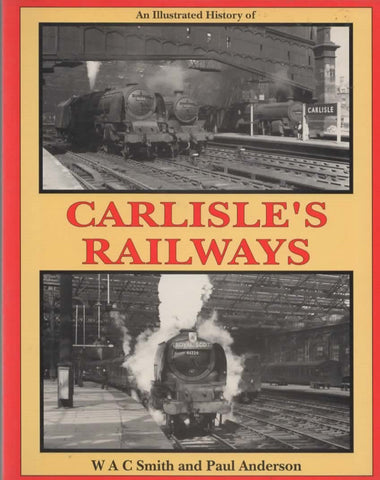An Illustrated History of: Carlisle's Railways (IR651)
Product No.: IR651
Title: An Illustrated History of: Carlisle's Railways
Author(s): Smith, W.A.C. & Anderson , Paul
Illustrator(s): N/A
Publisher: Irwell Press
ISBN: 1871608651
Condition: New
Binding: Softcover
Dust Jacket: None
Edition: 1st Edition
Publication Year: 1997
Features: 92 Pages with Black/White Photos.
The railway came into Carlisle, not just once but seven times, under the auspices of a series of different railway companies. The result within the city was a fascinating jumble of lines heading towards their own separate stations, and a battle between those gaining access to the centre and those initially denied it.The story of rail in the city begins however with a canal. Proposals have regularly been made to construct a canal cutting across the country and linking the Irish Sea with the North Sea via the Solway and the Tyne.
After a number of false dawns, what was hoped would be just the first section of the long distance route was opened in March 1823, connecting Carlisle with an exit to the Solway at what was christened Port Carlisle. This 11 mile stretch would in itself prove of great benefit to the growing city, facilitating as it did the import of raw materials and the export of finished goods to and from the canal basin situated a mile to the north-west of the city centre. Although demand was growing to complete the cross country link it did not take shape as a canal as originally planned but as a railway, which by that time was clearly the most cost effective option. Construction of the Newcastle and Carlisle Railway began in 1830, but it was not until 1838 that the line was completed to connect the two cities.
In Carlisle itself moreover the engineer had been faced with a difficult question - where should the line end? Should it terminate at the canal basin to complete the original plan, or nearer to the city centre for the convenience of passengers? The lure of revenue from the traffic in coal for export to the basin from collieries near Brampton to the east won the day, so a route across the lie of the land to the south of the city was chosen to allow this. Unfortunately for passengers this meant that the nearest the line approached the city centre was when it crossed under London Road, about three-quarters of a mile outside the city. It was here however that London Road Station was constructed, with the goods line continuing further as the Canal Branch. In 1843, the arrival of the second line to the city - the Maryport and Carlisle Railway - brought with it the complications and arguments which were to be a continuing feature of Carlisle's railway history, although not to begin with.
The Maryport and Carlisle - approaching the city from the south along the Caldew Valley - reached agreement with the Newcastle and Carlisle to turn east and join their Canal Branch for half a mile before reversing into London Road station which they would share. So far so good, but the directors of the Maryport and Carlisle had plans for a new station of their own closer to the city centre, and acquired a seven acre site at Crown Street. Objections were raised not only by the Newcastle and Carlisle but also by the approaching Lancaster and Carlisle whose plans were going through Parliament at the same time, both of which lines the Maryport and Carlisle would cross on the level! Construction of a temporary station at Crown Street was eventually agreed but using a similar join and reverse method of approach as at London Road. This was not to survive for long!
The through line from Lancaster to Carlisle opened in 1846 to the background of continuing disputes about the location and use of a new shared central station. Indeed for nine months the Lancaster and Carlisle Railway terminated in the Newcastle and Carlisle's London Road Station via a curve off its authorised route into the city. Trains from Lancaster and the south only began to use Court Square ( to be developed as Citadel Station) just outside the city's medieval walls in 1847. Agreement was finally reached for Maryport and Carlisle trains to use the new station in 1851, but not before their station at Crown Street had been totally demolished by a gang of one hundred Lancaster and Carlisle men, armed with picks and crowbars, in order



